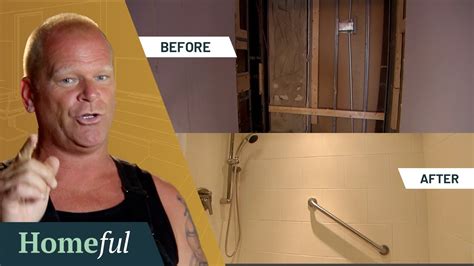
Mike Holmes, the renowned contractor and TV personality, is cautioning homeowners against a popular bathroom renovation trend: foregoing a bathtub for a solely shower-focused space. Holmes argues that while walk-in showers offer accessibility and modern aesthetics, eliminating the bathtub can negatively impact a home’s resale value and limit its appeal to future buyers, particularly families with young children.
Mike Holmes Debunks Bathtub-less Bathroom Trend: A Potential Home Value Gamble
Home renovation expert Mike Holmes is advising homeowners to reconsider ditching their bathtubs in favor of exclusively shower-based bathrooms. While the allure of a sleek, modern, and accessible walk-in shower is undeniable, Holmes warns that this trend could potentially decrease a home’s resale value and narrow its appeal to a specific demographic.
Holmes, known for his commitment to quality and practical advice, emphasizes that a bathtub remains a significant selling point for many homebuyers, especially those with young families. “While I love a walk-in shower – and they can be great for accessibility – removing a bathtub altogether isn’t always the best idea,” Holmes stated in a recent interview. He elaborated that “Families with young children often prioritize having at least one bathtub in the house,” making its absence a potential deal-breaker.
The trend toward shower-only bathrooms has gained traction in recent years, fueled by a desire for modern design, enhanced accessibility, and water conservation. Walk-in showers, with their curbless entries and spacious layouts, offer a user-friendly experience for individuals of all ages and abilities. They can also be customized with a range of features, such as multiple showerheads, built-in seating, and stylish tile designs, adding a touch of luxury to the bathroom.
However, Holmes points out that the perceived benefits of shower-only bathrooms must be weighed against the potential drawbacks. He argues that removing a bathtub eliminates a key feature that appeals to a broad segment of the market. This is particularly true in neighborhoods with a high concentration of families or in homes marketed towards first-time homebuyers.
“Think about who your potential buyers are,” Holmes advises. “If you’re in a family-oriented neighborhood, removing the only bathtub in the house could significantly limit your pool of potential buyers.”
Furthermore, Holmes suggests that homeowners consider the overall value proposition of their renovation projects. While a walk-in shower can enhance the functionality and aesthetics of a bathroom, it may not deliver the same return on investment as other upgrades that appeal to a wider range of buyers. He encourages homeowners to consult with real estate professionals and experienced contractors to assess the potential impact of their renovation choices on their home’s value.
The decision to remove a bathtub is not always a straightforward one. It depends on a variety of factors, including the homeowner’s personal preferences, the demographics of the neighborhood, the overall design of the house, and the long-term goals of the homeowner. In some cases, a shower-only bathroom may be a perfectly acceptable choice, particularly if the home has multiple bathrooms or if the homeowner plans to stay in the property for an extended period.
However, Holmes’s advice serves as a valuable reminder that home renovation projects should be approached with careful consideration and a clear understanding of the potential consequences. By weighing the pros and cons of different design choices and seeking expert guidance, homeowners can make informed decisions that enhance their living spaces without compromising their home’s long-term value.
Holmes also suggests creative solutions to address both accessibility and family needs. Instead of completely removing a bathtub, homeowners could consider installing a tub-shower combination with grab bars or a walk-in tub with a showerhead. These options provide the benefits of both a bathtub and a shower, catering to a wider range of users.
Ultimately, the decision of whether or not to remove a bathtub is a personal one. However, by taking into account the advice of experts like Mike Holmes, homeowners can make informed choices that align with their individual needs and goals, while also protecting their investment. The key takeaway is to carefully evaluate the potential impact of any renovation project on the home’s value and appeal, and to consider the long-term implications of design choices. Ignoring this advice could lead to disappointment when the time comes to sell. The decision is always personal, but should be well informed.
In addition to considering resale value, Holmes also cautions homeowners to think about their own future needs. Even if they don’t have young children currently, their lifestyle may change in the years to come. A bathtub can be a valuable asset for relaxation, therapeutic soaks, or even caring for elderly family members.
Therefore, before embarking on a bathroom renovation, homeowners should take a holistic approach, considering not only their current preferences but also the potential impact on their home’s value and their future needs. By doing so, they can create a bathroom that is both functional and stylish, while also protecting their investment for years to come.
Delving Deeper: Factors Influencing the Bathtub Decision
Beyond the immediate appeal of a modern shower, several underlying factors contribute to the increasing popularity of shower-only bathrooms. These include:
- Space Constraints: In smaller bathrooms, particularly in older homes or apartments, prioritizing a spacious walk-in shower over a bathtub can create a more open and functional layout. Removing the tub can free up valuable floor space, making the bathroom feel less cramped and more inviting.
- Accessibility Needs: For individuals with mobility issues, a walk-in shower offers a safer and more convenient bathing experience. Curbless entries, grab bars, and adjustable showerheads can make the shower more accessible and reduce the risk of falls.
- Water Conservation: Showers generally use less water than baths, making them a more environmentally friendly option. Many homeowners are drawn to shower-only bathrooms as a way to reduce their water consumption and lower their utility bills.
- Modern Aesthetics: Walk-in showers are often associated with contemporary design trends, featuring sleek lines, minimalist fixtures, and luxurious tile finishes. Homeowners seeking to update their bathrooms with a modern look may opt for a shower-only design to achieve a more sophisticated aesthetic.
- Aging in Place: As the population ages, there’s growing interest in home modifications that allow seniors to age in place comfortably and safely. Walk-in showers are a key component of age-friendly bathroom design, providing a secure and accessible bathing option for older adults.
However, while these factors may justify the decision to remove a bathtub in certain situations, it’s important to weigh them against the potential drawbacks, as highlighted by Mike Holmes. A balanced approach that considers both personal needs and market value is essential for making informed renovation choices.
Expert Opinions and Real Estate Perspectives
The debate over bathtubs versus showers is not limited to homeowners and contractors. Real estate professionals also have varying perspectives on the impact of removing a bathtub on a home’s resale value.
Some real estate agents argue that the absence of a bathtub is not necessarily a deal-breaker, particularly in certain markets or for certain types of buyers. They may point out that many homebuyers, especially younger generations, prioritize modern amenities and low-maintenance features over traditional bathtubs.
However, other real estate agents emphasize the importance of having at least one bathtub in the house, particularly for families with young children. They argue that the lack of a bathtub can limit the appeal of the home and potentially reduce its selling price.
“In my experience, homes with at least one bathtub tend to sell faster and for a higher price than homes without one,” says Sarah Miller, a real estate agent with over 15 years of experience. “Families with young children are often willing to pay a premium for the convenience of having a bathtub in the house.”
To gain a clearer understanding of the potential impact of removing a bathtub on a home’s resale value, homeowners should consult with local real estate agents and appraisers. These professionals can provide valuable insights into the specific market conditions in their area and assess the potential impact of renovation choices on the home’s value.
Mitigating the Risks: Strategies for a Balanced Approach
For homeowners who are considering removing a bathtub but are concerned about the potential impact on their home’s value, there are several strategies they can employ to mitigate the risks:
- Keep at Least One Bathtub: If the home has multiple bathrooms, consider keeping a bathtub in at least one of them. This provides the option of a bathtub for those who prefer it, while still allowing for a shower-only bathroom in another part of the house.
- Install a Tub-Shower Combination: A tub-shower combination offers the best of both worlds, providing the convenience of a shower and the option of a relaxing bath. This can be a good compromise for homeowners who want to update their bathroom without completely eliminating the bathtub.
- Consider a Walk-In Tub: Walk-in tubs offer a safe and accessible bathing option for individuals with mobility issues. They feature a low step-in height, grab bars, and a built-in seat, making them ideal for seniors or those with disabilities. Some walk-in tubs also include showerheads, allowing for both bathing and showering.
- Focus on High-Quality Finishes: When renovating a bathroom, invest in high-quality finishes and fixtures that will appeal to a wide range of buyers. This includes stylish tile, modern faucets, and energy-efficient lighting.
- Maintain a Clean and Updated Aesthetic: Regularly clean and maintain the bathroom to keep it looking its best. A fresh coat of paint, updated hardware, and stylish accessories can enhance the overall appeal of the space.
- Consult with a Real Estate Professional: Before making any major renovation decisions, consult with a local real estate agent to get their expert opinion on the potential impact on the home’s value. They can provide valuable insights into the specific market conditions in the area and help homeowners make informed choices.
- Document the Renovation Process: Keep detailed records of the renovation process, including receipts, permits, and before-and-after photos. This documentation can be helpful when selling the home, as it demonstrates the quality of the work and the value of the upgrades.
By implementing these strategies, homeowners can minimize the potential risks associated with removing a bathtub and ensure that their renovation project enhances the value and appeal of their home.
Case Studies: Real-World Examples
To illustrate the potential impact of removing a bathtub on a home’s resale value, let’s examine a few real-world case studies:
- Case Study 1: Family Home in a Suburban Neighborhood: A family with two young children decided to renovate their only bathroom, removing the bathtub and installing a large walk-in shower. While they enjoyed the modern design and enhanced accessibility, they later found it difficult to sell their home when they decided to move. Many potential buyers with young children were hesitant to purchase a home without a bathtub, and the home ultimately sold for less than comparable properties in the area.
- Case Study 2: Condo in a Downtown Urban Area: A young professional decided to renovate the bathroom in their condo, removing the bathtub and installing a sleek, modern shower. The condo was located in a downtown urban area with a high concentration of young professionals and no children. The renovation enhanced the appeal of the condo to this demographic, and it sold quickly for a price that was comparable to other units in the building.
- Case Study 3: Retirement Home in a 55+ Community: A retired couple decided to renovate the bathroom in their retirement home, removing the bathtub and installing a walk-in shower with grab bars and a built-in seat. The renovation made the bathroom more accessible and safer for them as they aged, and it also enhanced the appeal of the home to other retirees in the community. The home sold quickly and for a good price.
These case studies demonstrate that the impact of removing a bathtub on a home’s resale value can vary depending on a variety of factors, including the location of the home, the demographics of the neighborhood, and the overall design of the house.
Conclusion: A Balanced Perspective on Bathroom Renovations
Mike Holmes’s warning about the bathtub-less bathroom trend serves as a valuable reminder for homeowners to approach renovation projects with careful consideration and a clear understanding of the potential consequences. While the allure of a modern, accessible shower is undeniable, it’s essential to weigh the benefits against the potential impact on the home’s resale value and appeal to future buyers.
A balanced approach that considers both personal needs and market value is crucial for making informed renovation choices. By consulting with real estate professionals, experienced contractors, and considering the demographics of the neighborhood, homeowners can make decisions that enhance their living spaces without compromising their long-term investment. The key is to think beyond immediate gratification and consider the long-term implications of any design choices. Ultimately, the goal is to create a bathroom that is both functional and stylish, while also protecting the value of the home for years to come. Remember also to consider your own future requirements and lifestyle changes.
Frequently Asked Questions (FAQ)
Q1: Why does Mike Holmes advise against removing bathtubs in bathroom renovations?
A: Mike Holmes cautions against removing bathtubs because they remain a significant selling point for many homebuyers, especially families with young children. Eliminating a bathtub can potentially decrease a home’s resale value and narrow its appeal to a specific demographic, thus limiting the pool of potential buyers.
Q2: What factors should homeowners consider before removing a bathtub?
A: Homeowners should consider several factors, including their personal preferences, the demographics of their neighborhood (especially the prevalence of families), the overall design of their house, and their long-term goals for the property. Consulting with real estate professionals and experienced contractors is also advisable.
Q3: Are there situations where removing a bathtub is acceptable or even beneficial?
A: Yes, there are situations where removing a bathtub is acceptable. These include homes with multiple bathrooms (where at least one bathtub is retained), smaller bathrooms where a spacious walk-in shower is preferred for functionality, and homes in areas with a high concentration of young professionals or retirees where the demand for bathtubs is lower.
Q4: What are some alternatives to completely removing a bathtub that still offer accessibility and modern design?
A: Alternatives include installing a tub-shower combination with grab bars, a walk-in tub with a showerhead, or a deeper soaking tub that is still easier to enter and exit than a traditional tub. These options provide the benefits of both a bathtub and a shower, catering to a wider range of users.
Q5: How can homeowners mitigate the potential negative impact of removing a bathtub on their home’s resale value?
A: Homeowners can mitigate the impact by keeping at least one bathtub in the house, focusing on high-quality finishes and fixtures in the renovated bathroom, maintaining a clean and updated aesthetic, and consulting with a real estate professional before making any major renovation decisions. Documenting the renovation process is also beneficial.









